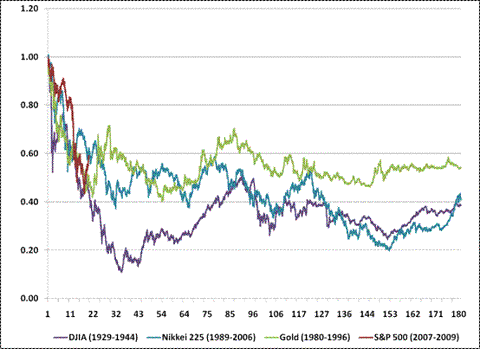John
Hussman: Post Crash Bubbles
Excerpt from the Hussman Funds' Weekly Market Comment
(5/11/09):
It would be very convenient if it was
possible to buy the fear lows, participate in the bear market rallies, sell at
the peaks, and repeat. Unfortunately, “fear” lows are only evident in
hindsight, because as we saw in 2008, a deeply oversold market can become
spectacularly more oversold before recovering, and the “fast, furious” spikes
off of those lows are often followed by steep failures. Fear lows are only easy
to identify in hindsight.
Even if we have observed the ultimate
lows of this downturn (which I would not take as given), it does not follow
that the decline we've observed over the past 18 months will be progressively
recovered without a great deal of intervening difficulty. The S&P 500 has
retraced just over 25% of its bear market loss. The 904 level on the S&P
500 was a 25% retracement, and 977 would be a 1/3 retracement, which is not
unreasonable. Aside from such retracements, the idea of a “V-shaped” recovery
in the market is strongly odds with “post-crash” market behavior, which
generally features a long and drawn-out flat period for years afterward.
Given the enormous overhang of Alt-A and option-ARM resets scheduled to begin
later this year, extending into 2012, such a profile would not be surprising in
the present case.
To put the current downturn into similar
context, the chart below overlays several historical crashes, with the time
scale measured in months. The downturns include the Great Depression (purple),
the Japanese Nikkei index which peaked in 1989 (blue), the gold market which
peaked in 1980 (green), and the S&P 500 which peaked in 2007 (red). Thanks
to Bill Hester for preparing this overlay.
Note that during all of these downturns,
the markets did experience very powerful intervening advances as well (indeed,
the rally off of the initial 1929 market crash approached 50% before failing).
In each case, however, the fundamentals of the preceding bubble had been
broken and it took years for the markets and economy to adjust. In the
case of gold, the shift in fundamentals was the end of double-digit inflation.
In the other instances, including the present one, the shift was from a steeply
leveraged economy to a deleveraging one.
To a great extent, the optimism of
investors is based primarily on economic “flow” data (spending, job losses,
confidence measures) that remain poor, but have been “less bad” than expected.
What concerns me far more, however, is that there is a second and almost
equivalent mountain of mortgage resets and probable defaults that will begin
later this year and extend into 2012. While our unelected bureaucrats have
spent over a trillion dollars to make reckless lenders whole, they have done
nothing to materially ease foreclosures or avert the oncoming second wave.
